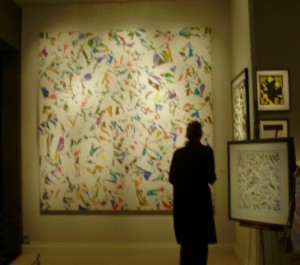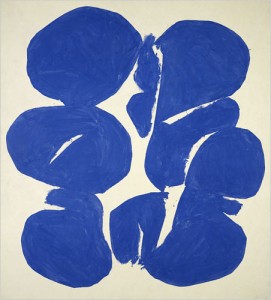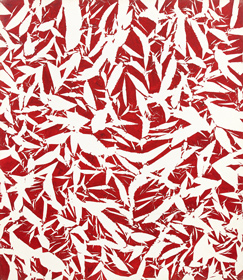 If I’d come across the artist Simon Hantai before I went to TEFAF Maastricht this year, I don’t remember him. But one booth (Galerie Beres, I think) featured several works by him, and I was intrigued enough to take a couple of pictures so that I could remember to look him up upon my return (the top two photos here, and sorry about the fuzziness).  Â
If I’d come across the artist Simon Hantai before I went to TEFAF Maastricht this year, I don’t remember him. But one booth (Galerie Beres, I think) featured several works by him, and I was intrigued enough to take a couple of pictures so that I could remember to look him up upon my return (the top two photos here, and sorry about the fuzziness).  Â
It turned out that I didn’t really need the reminder, because within days, the National Gallery of Art announced the acquisition of Etude (1969)Â by Hantai, its first painting by him.
That sent me to his 2008 obit in The New York Times, which explained my deficiency (a bit). It described him as “a highly regarded, famously reclusive French painter whose work explored ideas of absence and silence,” and elaborated:
In 1982, Mr. Hantaï represented France at the Venice Biennale. Later that year, he withdrew from view, in what he described as a reaction against the rampant commercialization of art and the state’s unwelcome involvement in the making of art. Retreating to his home in Paris, he rarely left the house and refused requests to exhibit his paintings. But over the next decade and a half, Mr. Hantaï quietly produced what many critics believe to be his finest work.
The obit continued, describing his invention of a process known as pliage:Â
In 1960, Mr. Hantaï began to manipulate and crease his canvases before carefully brushing them with bright liquid color. Where most painters saw canvas as merely a surface to hold paint, Mr. Hantaï focused on its essential physical nature: it was a textile that could be folded, scrunched or tied before paint touched it.
The result, when his painted canvases were unfolded, was repeating patterns of jagged whiteness that could suggest ice crystals, geologic rifts or leaf forms. The paintings seemed punctuated by absence — a kind of visual silence — a telling motif for an artist who was an exile. Mr. Hantaï’s important folded paintings include the series “Mariales†(“Cloaksâ€), “Whites†and “Tabulas.â€
And his red Etude, above right.
 The NGA says that  the Pompidou Centre is working on a retrospective of Hantai’s work next year, which it expects “will bring him international attention.” Wouldn’t it be nice if that exhibit were coming to the U.S.? The Metropolitan Museum owns no works by Hantai, and the Modern, which owns two, has neither on view. Nothing comes up in a search at the Guggenheim, SF MoMA, LACMA, MFA-Boston, the Philadelphia Museum or the Art Institute of Chicago, either.
The NGA says that  the Pompidou Centre is working on a retrospective of Hantai’s work next year, which it expects “will bring him international attention.” Wouldn’t it be nice if that exhibit were coming to the U.S.? The Metropolitan Museum owns no works by Hantai, and the Modern, which owns two, has neither on view. Nothing comes up in a search at the Guggenheim, SF MoMA, LACMA, MFA-Boston, the Philadelphia Museum or the Art Institute of Chicago, either.
I wonder if it’s still possible for an American museum to ask for the Hantai. I’d certainly like to see more, and a simple request — even after an exhibit is on view — has been known to work before. At left, btw, is Blue Muen from 1967.
 Photo Credits: Etude, courtesy of NGA; Blue Meun, Courtesy of Paul Rodgers / 9W Gallery

